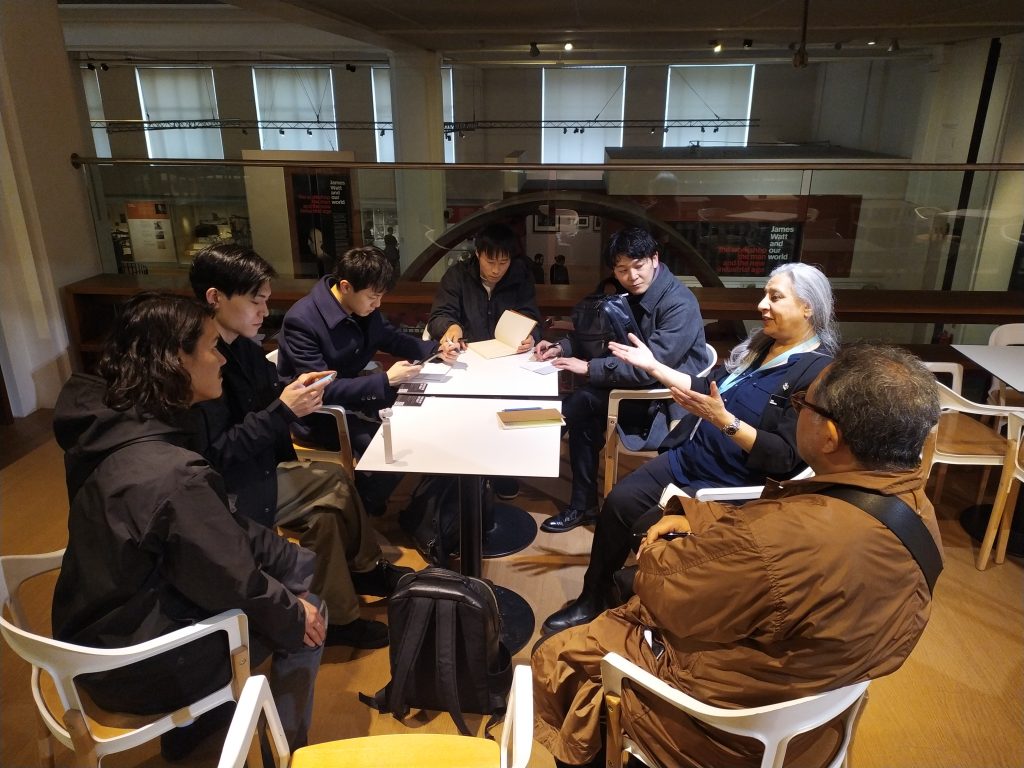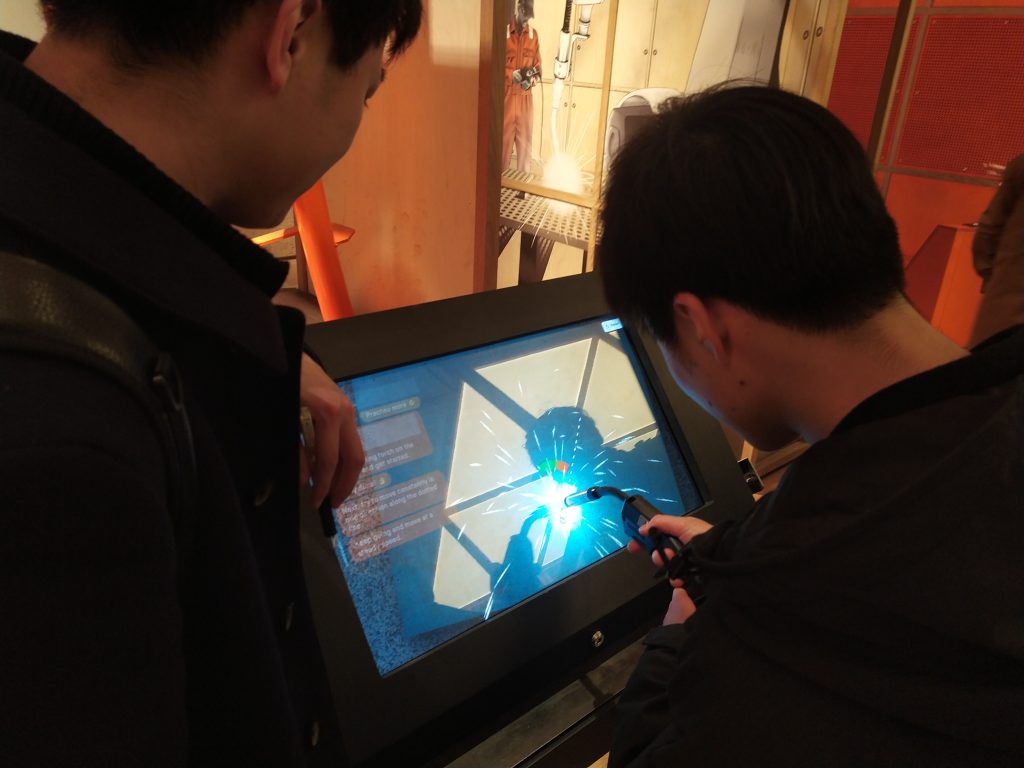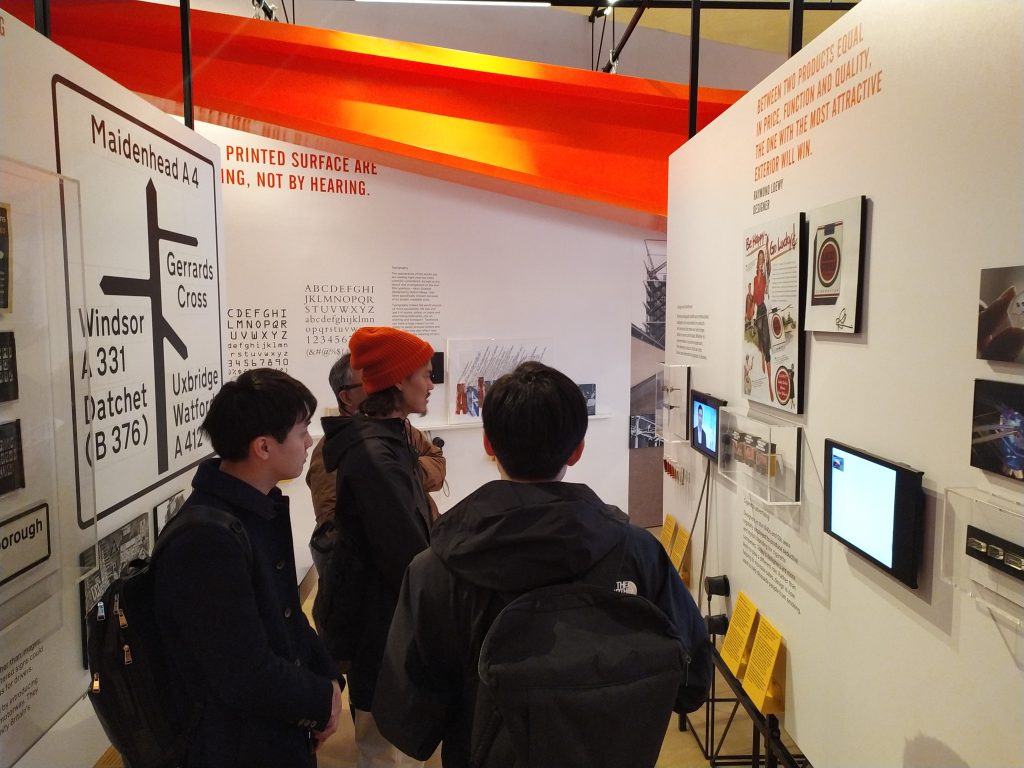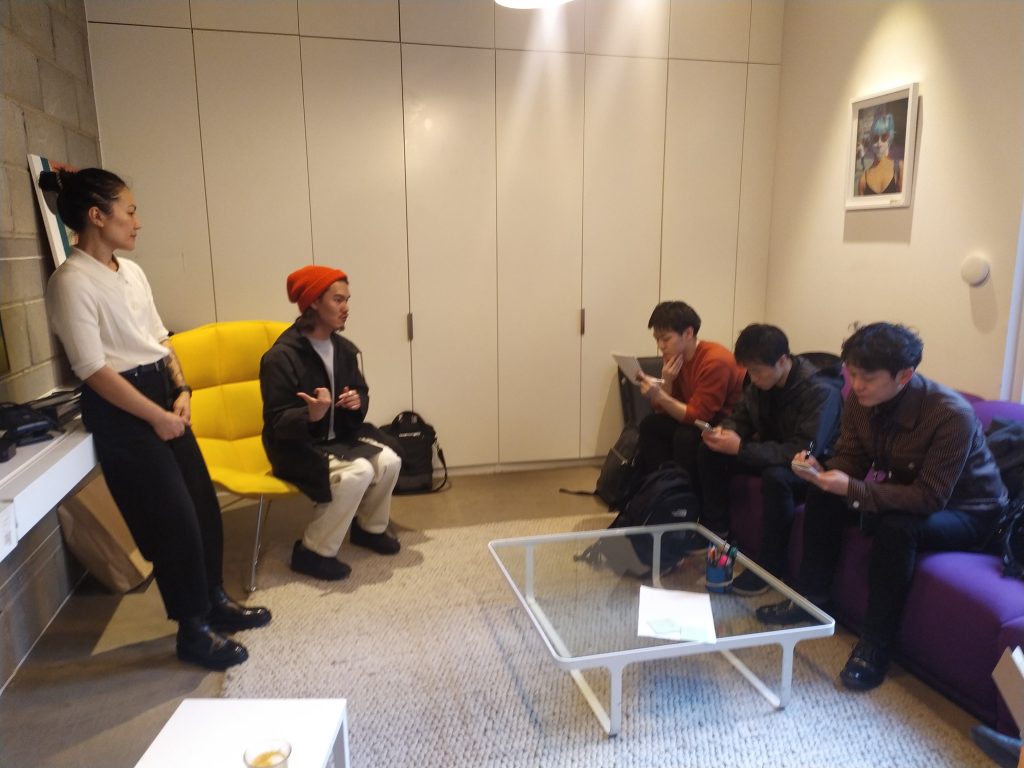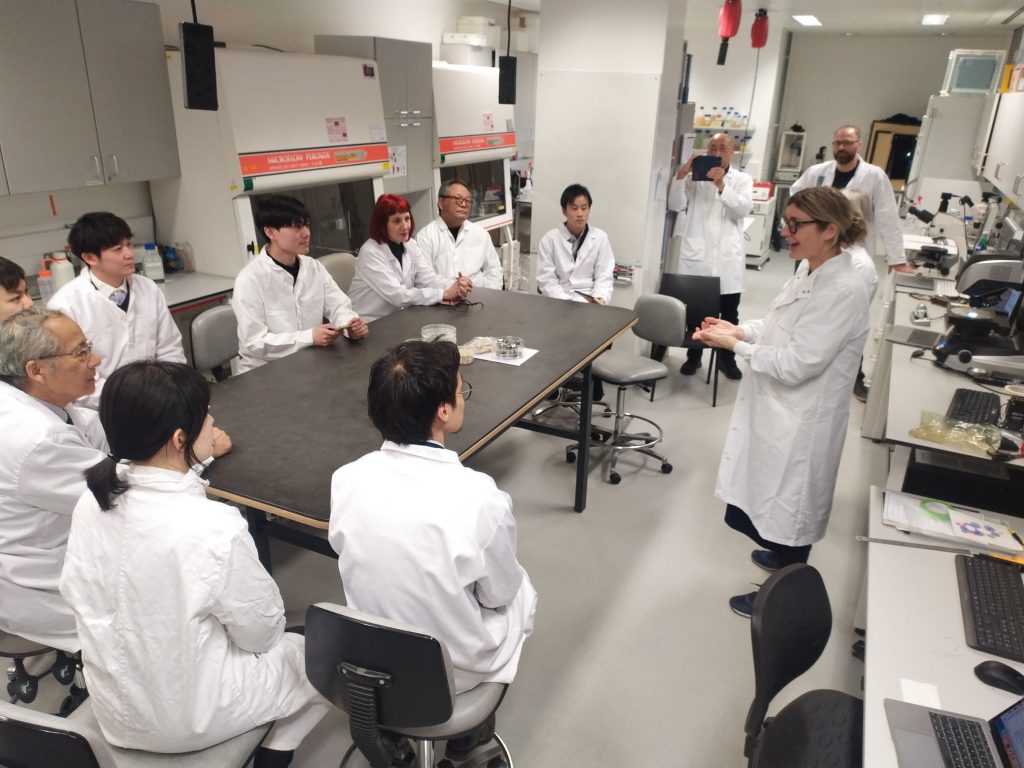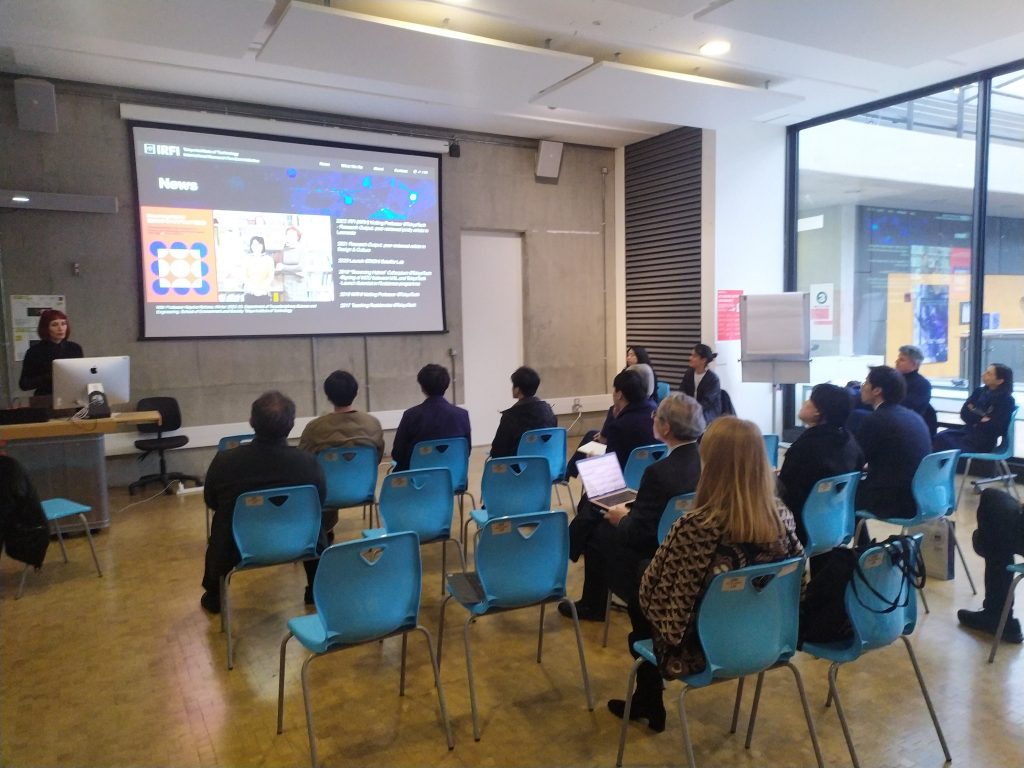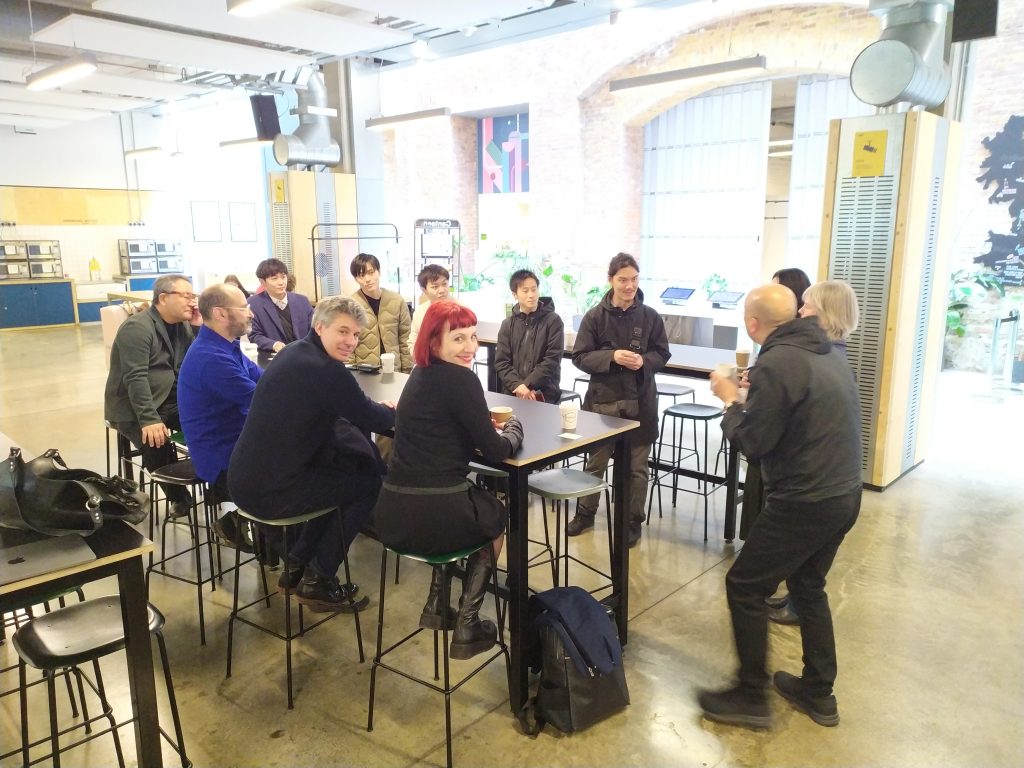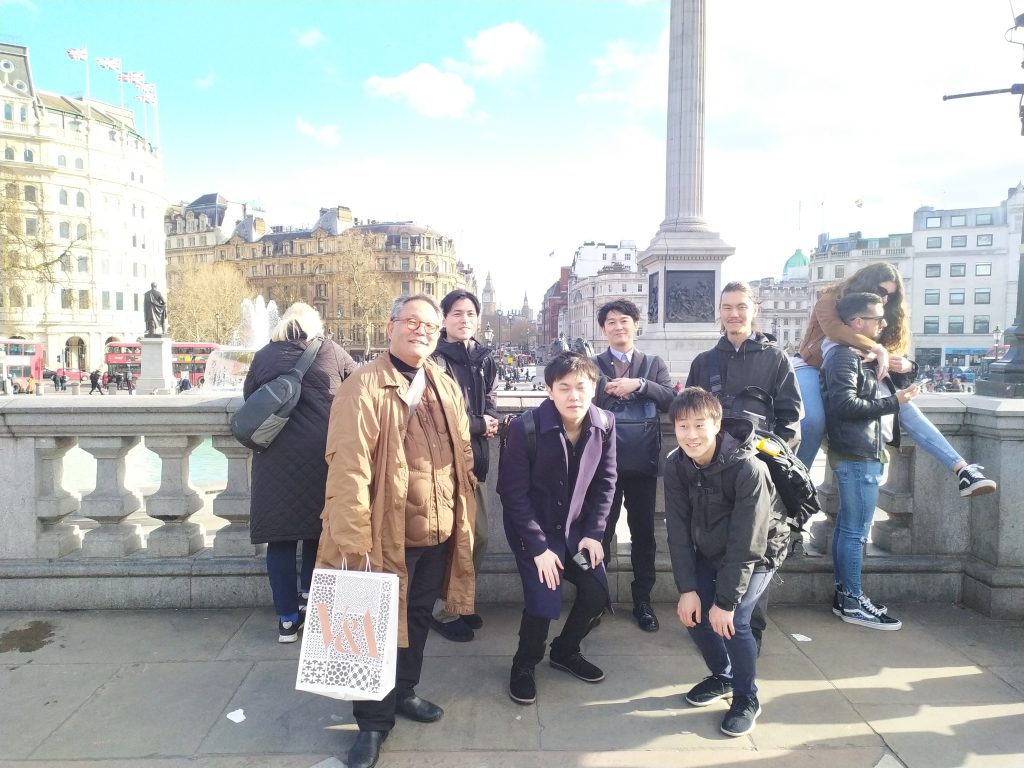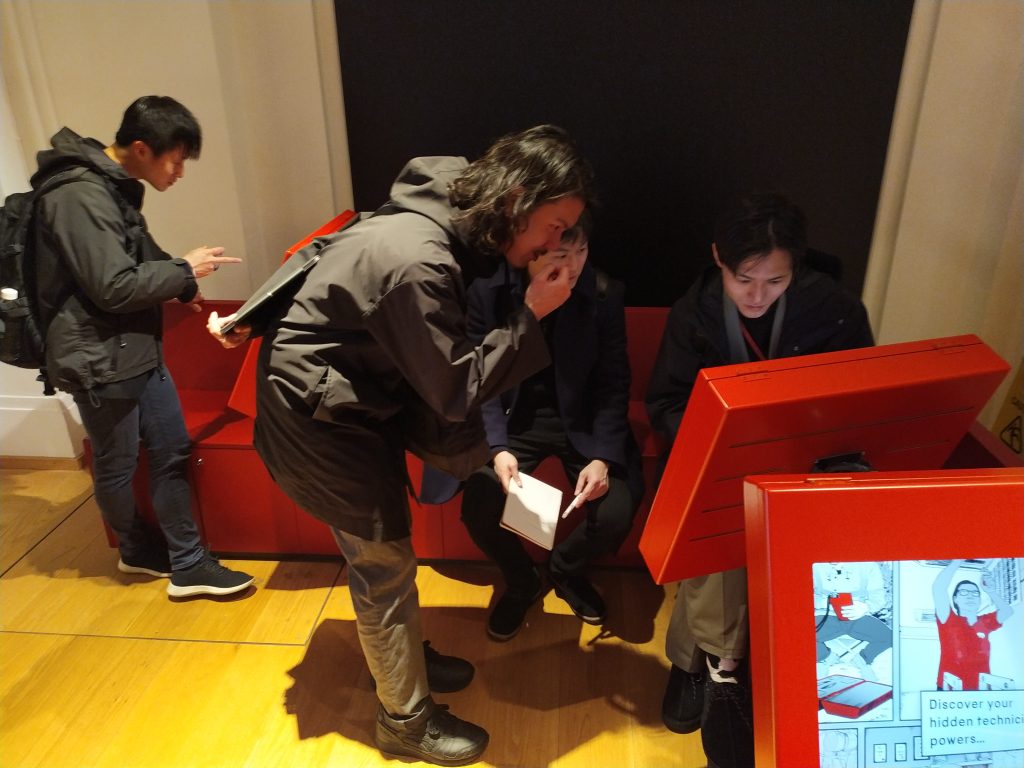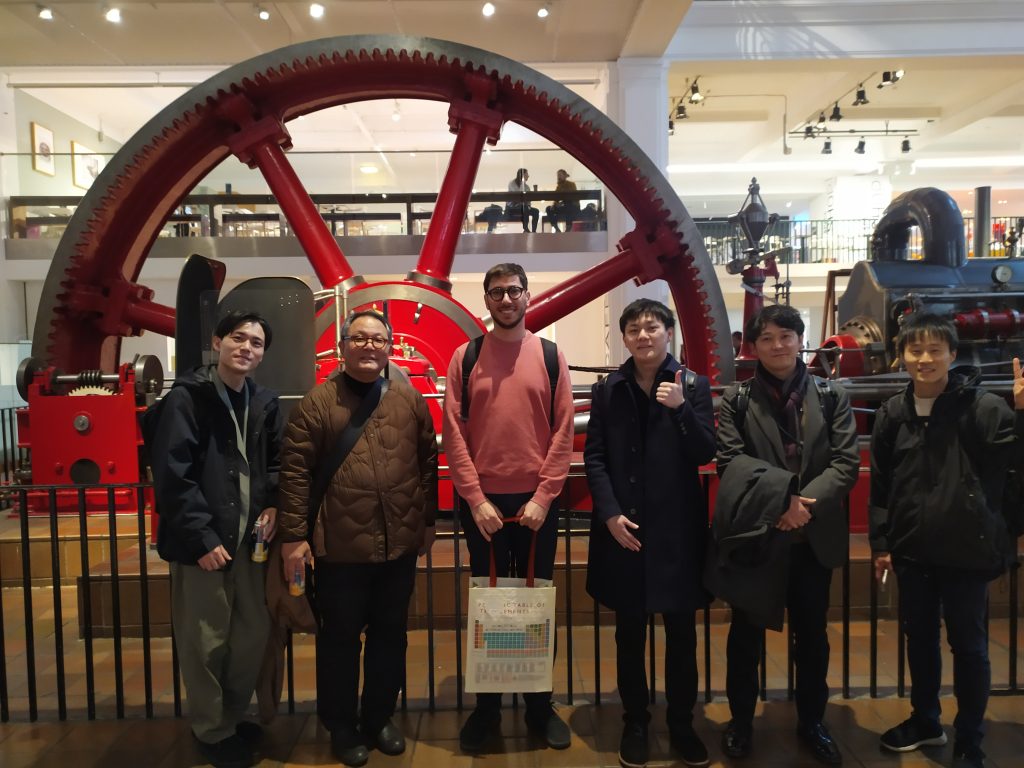東工大環境・社会理工学院 産学協働プログラム「未来を創る”Hybrid Innovation” 」プログラム (HI) は、アート、デザイン、サイエンス、エンジニアリングの手法を統合し、革新的なアイデアを生み出すプロセスやツールを体験する全10回のワークショップで構成されています。このプログラムは野原佳代子教授が主宰し、東工大と英国ロンドン芸術大学セントラル・セント・マーティンズ校(CSM)から広く講師を招聘して運営しています。今回はオプション企画として、5名の参加者がロンドンツアーに参加。クリエイティブディレクターのジョルジョ・サラニ博士とアシスタントディレクターの鹿又康平とともに、ロンドンの文化施設やイノベーションハブを巡り、CSMでのワークショップに参加しました。上記2名が全行程をアテンドし、鹿又が日本語通訳を担当しました。今回の海外視察を通して、ハイブリッド・イノベーションの手法の有効性や、学際的イノベーションの実例を実地で確認することができました。博物館、美術館、現地企業などを訪問し、ただ見学するのみでなく専門家やグループ内での幅広いディスカッションが実現しました。以下、ご報告です。
まず科学博物館からスタート。インタラクティブ・ギャラリーのチームリーダーであるJin Nirwal氏の歓迎を受け、ギャラリーの歴史特に1851年の万国博覧会との関連について説明されました。展示室では、第一次産業革命における技術史や、近代社会の発展において英国(さらに日本とも関連付け)が果たした役割について解説がありました。その後、David Sainsbury’s Galleryにある、ティーンエイジャーが技術者になるための新スペース「Technicians」を、プライベートツアーとして見せていただきました。ここではバーチャル溶接機など、さまざまな製造・技術プロセスをデジタルで体験するとともに、興味のあることやスキルについて回答する「技術者としての将来のキャリア」を確認するテストにもトライすることができました。展示物とのインタラクションは記憶に残る新体験となり、それは参加者のコメントや議論に反映されています。
科学博物館に続い、ウェルカム・ギャラリーを訪問。まずミュージアムガイドにより医学関連の作品が紹介されました。マーク・クインの大型のブロンズ彫刻”Self-Conscious Gene”は、人の病状、アイデンティティ、自己認識の問題に取り組む作品であり大きな存在感を放っています。このギャラリーはアートとサイエンスの密接な歴史的つながりを見事に表現しており、数々のアート作品だけでなく、芸術的な美しさと高度な職人技が光る医療器具や模型も展示されていました。各ギャラリーを十分に見て回った後は、近くにあるヴィクトリア&アルバート美術館に移動し、世界で最も古いミュージアムカフェで昼食をとりました。ウィリアム・モリスやイギリスのアーツ&クラフツ運動によるデザインから、西洋の美術史、日本の民芸品との関係、デザインや装飾に対する美意識の違い(空間畏怖から禅ミニマリズムまで)などについて、とめどなく議論。その後はグループごとに美術館を散策し、コレクションの中からそれぞれが気になる作品を探し出しガイドとともに探求。ラファエル前派やジョン・コンスタブルの絵画、宝飾品や陶磁器のギャラリーは特に注目されました。続いて、市内中心部の主要な建築物を巡る歴史ツアーが行われました。
2日目は、デザインミュージアムの常設展を見学。モダンデザインの歴史的変遷に触れ、日本の文化施設とは異なるナラティブに思いを馳せました。
“デザインミュージアムでみた展示方法に対して、日本がプロダクト自体にフォーカスしているのに対して、それを使う人やそのデザインができる背景に重きを置いているのを見てデザインに対する考え方の違いを学んだ。” HI 2022-23参加者
ケンジントンでの昼食後、一行はイーストロンドンに移動。「空間が私たちを結びつけると信じる探索的建築デザインスタジオ」を自認するスペースラボを訪問しました。クリエイティブ・ストラテジストであるFirst Sukpaiboon氏にスタジオを案内するとともに、都市デザインにおける共同プロジェクトのアプローチ、課題、教訓について詳しく説明していただきました。質疑応答では、イノベーションのアイデアやモデル、クライアントや市民との関わり方の難しさ、分野や業界を超えたプロフェッショナルとの協働、都市や建築プロジェクトにおけるアートやデザインの方法論の価値などについて、熱心に意見が交わされました。スタジオビジットに感謝し、次に一行は鹿又氏の案内で、イースト・ロンドンの文化的ランドマークを探索しました。イースト・ロンドンは、街の中心部や宿泊先のあるウエスト・ロンドンとは異なる歴史と特徴を持つ地域です。ロンドン滞在中は、正規のプログラム外にもオプションで、さらなるギャラリー巡りや夜の音楽会などの文化活動が用意されており、みなさまに楽しんでいただきました。
“Spacelab_の会社訪問にて、コミュニティーデザインの方法を学んだ。デベロッパー案件以外のやり方で市民を中心に活動する際のリーダーシップのあり方など、日本とは異なるプロジェクトの作り方を学んだ。” HI 2022-23参加者
3日目は、キングスクロス駅北側に位置するセントラル・セント・マーティンズ美術大学(Central Saint Martins College of Art and Design)を訪問。GoogleやMetaのオフィスがある新地区を散策した後、CSMの国際パートナーシップ責任者であるJosef Wheeler博士による温かい歓迎を受けました。一行は東工大の原正彦教授やCSMの研究者たちと合流し、まずは大学のおしゃれな食堂でコーヒーを飲みながらネットワーキング。その後Wheeler博士が施設を案内、建物の建築デザインの背景や、大学で使用されている教育モデルとの関連性を説明していただきました。見学ツアーでは、ファッション・テキスタイル、セラミック、工業デザイン、版画、デジタルファブリケーションなど、主要なエリアを贅沢に見学することができました。彼らの持つ有名な図書館でも、図書館員に歓迎され「デザインと製造の現在のトレンドを表す、新しく革新的な材料」を所蔵する「材料と製品コレクション」を紹介していただきました。大学での昼食後は、CSMスタッフによる産業界とのコラボレーションの革新的アプローチに関するプレゼンテーションを聴講。また、元学生や在学生たちが、受賞したアート作品やデザインプロジェクトについて発表してくれました。デザインやイノベーションへのアプローチについて、つっこんだ質問をし議論する貴重な機会にもなりました。
“ワークショップではプロジェクトの進め方、リサーチ方法に哲学の要素が多用されていて、自分たちの会社でも利用できる可能性を感じた。” HI 2022-23参加者
午後は、MA Art and Science大学審コースのパスウェイリーダーであるHeather Barnnet氏と、CSMのScientist in Residenceとして滞在中の原正彦教授主導の実験活動に参加しました。科学者、アーティスト、技術者、その他のスタッフらとともに、大学内の生物学実験室”Grow Lab“にて実験。原教授によるショートレクチャーでは、現在の技術の限界を克服するために、計算に対する別のアプローチが必要であることが説明されました。単細胞生物である粘菌は、様々な数学的問題に対して興味深い解決策を示してくれています。「ベストな」解に到達しようとすると時間がかかるのですが、むしろ「平均より良い」くらいの解を生み出す能力は高い。こうした自然科学における「曖昧さ」や「不確実性」の概念は、東工大でのHIセッションでも紹介されているように原教授の研究の焦点となっています。参加者たちはシャーレに粘菌のために餌(ロールドオーツ)と障害物を置き、彼らが時間をかけて一定の方向に成長するパターンをデザイン。こうして粘菌類に向かって課題や問いを投げかけたあと、タイムラプス写真により、彼らの数日間の行動を記録する実験調査活動に参加しました。
“訪問先のクリエイティブ機関の活動全体が「結論に行き着くまでのプロセスの大切さ」を説いている印象を強く受けました。ビジネスにおいても、最終的な成果物だけを重要視するのではなく、限られた時間の中でもプロセスをより深く追求した仕事を行うべきであることを学びました。実りある素晴らしいツアーを企画してくださりありがとうございました。” HI 2022-23参加者
The Hybrid innovation programme for industry (HI) at the Tokyo Institute of Technology (Tokyo Tech) consists of 10 workshop sessions in which participants experience a the integration of art, design, science and engineering methodologies for the promotion of innovative ideation processes and tools. The programme is run by Prof. Kayoko Nohara and includes contributions from guest lecturers from Tokyo Tech and Central Saint Martins college of art and design, University of the Arts London, UK. As part of an optional offer within the programme, a group of 5 participants joined creative director Dr Giorgio Salani and assistant director Kohei Kanomata in a tour of cultural institutions and innovation hubs in London, UK, which ended with a workshop day at CSM. The hosts accompanied the group in all activities, with Mr Kanomata providing Japanese translation throughout. The visit abroad provided further confirmation of the validity of the Hybrid Innovation approach and real cases of transdisciplinary innovation in action. Visits to museums, galleries and companies were accompanied by extensive discussions with professionals and within the group.
The group was welcomed to the science museum by Jin Nirwal, Team Leader of Interactive Galleries, who gave an overview of the history of the galleries and their link to the Great Exhibition of 1851. This offered insights into the history of technology during the first industrial revolution and the role Britain (and Japan by contrast) played in the development of modern society. This was followed by a private tour of the Technicians exhibit in the David Sainsbury’s Gallery, a new space to help teenagers become technicians. Here, the group could experience various manufacturing and engineering processes in digital form, like a virtual welding machine, and complete a test to identify your future career as a technician by answering questions about interests and skills. The interaction with the exhibits produce memorable experience which informed comments and discussion in the group.
The Wellcome Galleries were next, where a museum guide introduced artworks related to medical science. The group discussed ‘Self-Conscious Gene’, a large bronze sculpture by Marc Quinn that – in addition to having a grand presence in the room – engages with issues around medical conditions, identity and self-awareness. This particular gallery was a perfect manifestation of the close historical link between art and science, not only hosting numerous artworks but also medical tools and models of great artistic beauty and greatly accomplished craftsmanship. After some time to freely roam around the galleries individually, the group moved to the Victoria & Albert museum nearby, where they had lunch in the oldest museum café’ in the world. Designs by William Morris and the British Arts & Crafts movement inspired conversations on Western history of art, its relationship with Japanese Mingei craft and the different aesthetic sensibility towards design and decoration (from ‘horror vacui’ to zen minimalism). The group then visited the museum individually and the guides helped identify artworks of personal preference within the collection. Pre-Raphaelites’ and John Constable’s paintings, the jewellery and ceramics galleries were particularly notable. The day continued with a historical tour of key architectural landmarks in the city centre.
The second day on site started with a visit to the permanent collection of the Design Museum, where the group engaged with the historical evolution of modern designs and reflected with the different narrative the museum offered when compared to Japanese cultural institutions.
“I learnt about the different ways of thinking about design from the exhibition methods I saw at the Design Museum, where the emphasis in Japan is on the product itself, whereas the emphasis is on the people who use it and the background to its design.” HI 2022-23 participant
After lunch in Kensington, the group moved to East London for a visit to SpaceLab, a company that self-identifies as an “exploratory architectural design studio that believes space unites us”. Creative Strategist First Sukpaiboon welcomed the team with a tour of the studio and a in-depth discussion of their approach, challenges and lessons learnt from collaborative projects in urban design. The intense Q&A covered ideas and models of innovation, difficulties with client and public engagement, working with professionals across disciplines and industries, and the value of art and design methodology in urban and architectural projects. Grateful for their time at the studio, the group then continued with a tour led by Mr Kanomata of cultural landmarks of East London, an area with a very distinct history and character from the city centre and West London, where their accommodation was located. Over the days the group engaged in optional cultural activities such as other gallery visits and evening music concerts.
“During a company visit to _Spacelab_, the participants learnt about community design methods. They learnt how to create projects that are different from those in Japan, such as the leadership style in working with citizens in ways other than developer projects.” HI 2022-23 participant
The third day was entirely dedicated to a visit to Central Saint Martins college of art and design, in the recently developed area north of Kings Cross station. This started with a walk in the new neighbourhood where the Google and Meta offices are located, before being welcomed to the university by Dr Joseph Wheeler, the Head of International Partnerships at CSM. The group joined Prof. Masahiko Hara from Tokyo Tech and other CSM academics for a networking event over coffee in the college’s stylish canteen. Dr Wheler then offered a tour of the facilities, explaining the rationale behind the architectural design and how it linked to the educational model in use at the university. The tour gave exclusive access to key areas in the building, including the departments of fashion and textiles, ceramics, industrial design, printmaking and digital fabrication. Librarians then welcomed the group to the library and its Materials and Products Collection, which hosts “new and innovative materials that represent current trends in design and manufacturing”.After lunch at the college, the group attended presentations by CSM staff on innovative approaches to collaborations with industry. Former and current students presented their work including award-winning art and design projects. The group had the chance to ask detailed and informative questions about their approaches to design and innovation.
“The workshop used many elements of philosophy in the way projects were carried out and research methods were used, and we saw the potential to use this in our own companies.” HI 2022-23 participant
The afternoon saw the participation in an experiment led by Heather Barnet, Pathway Leader MA Art and Science, and Prof. Masahiko Hara, coming from Japan as the Scientist in Residence at CSM. Thr group joined the scientists, artists, technicians and other staff in the Grow Lab, a biological laboratory located within the art college. A short lecture by Prof. Hara covered the need for alternative approaches to computation to overcome the limitation of current technologies. Slime mould, a free-living single-celled organism, offers interesting solutions to various mathematical problems because of its ability to produce “better than average” solutions, rather than rigid trying to reach the “best” one, which can often take a disproportional amount of time. These and other notions of ‘ambiguity’ and ‘uncertainty’ in natural sciences are the focus of Prof. Hara’s work, as anticipated in a HI session previously held in Tokyo. The group engaged with experimental design of patterns on a petri dish, onto which the food (rolled oats) and obstacles could inspire the organism to grow in certain directions over time. The experiment was to pose certain problems or questions to the slime mould and then use time lapse photography to record its behaviour over a period of a few days.
After setting up the dishes and discussing potential outcomes with the organisers, the conversation moved back to the lecture room with further presentations and networking opportunities. The later sessions were joined by the London office of the Japan Society for the Promotion of Science (JSPS) which is a leading funding body for Japan-UK collaborative research. This was followed by a social event in the evening.The group visited the Grow Lab at CSM again the morning of the last day to check initial results of the experiments and discuss it with the scientists. They then visited the Tate Modern, a landmark art museum in the city before engaging in other visits and optional activities. The trip to London consolidated the HI network and offered multiple opportunities to experience first hand the union of art, design, science and engineering in a foreign context, with the potential to inspire further insights into the evolution of technology, innovative business models, art-science research and methodologies, and generally engage with a prolific and inspiring cultural environment for which London is known all over the world. The group then safely returned to Tokyo and will meet again at the HI Symposium to be held at Tokyo Tech on 14th April.
“I got the strong impression that the entire activity of the creative institutions we visited preached the importance of the process of reaching a conclusion. We learnt that in business, too, we should not only focus on the final deliverables, but also work more deeply on the process, even in the limited time available. Thank you for organising such a fruitful and wonderful tour.” HI 2022-23 participant
